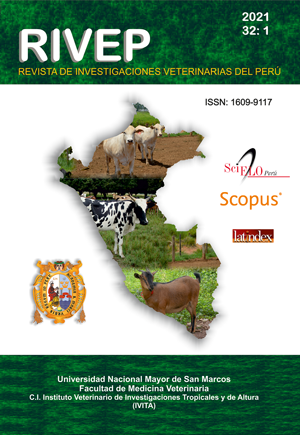Frequency of pathogens associated with cervical lymphadenitis in guinea pigs of family-commercial breeding centers in Cusco, Peru
DOI:
https://doi.org/10.15381/rivep.v32i1.19505Keywords:
guinea pig, cervical lymphadenitis, Streptococcus, antibiogramAbstract
The aim of this study was to identify and evaluate the antibiotic susceptibility of the main bacterial pathogens isolated from cases of cervical lymphadenitis in guinea pigs from two commercial-family breeding centres in the province of Canchis, Cusco. In total, 64 samples of cervical abscesses were processed between September 2018 and March 2019. The samples were cultured and the antibiogram on agar with discs of the main antibiotics used in family-commercial rearing systems was carried out. Beta-hemolytic Streptococcus sp (91.8%, 56/61), Staphylococcus sp (45.9%, 28/61) and Klebsiella sp (21.3%, 13/61) were identified. The highest frequency of isolates occurred in adult guinea pigs. The frequency of antimicrobial susceptibility was high for all the isolated genera, except for enrofloxacin and trimethoprim-sulfamethoxazole for beta-hemolytic Streptococcus sp. The results show a diversity of bacterial agents present in cervical lymphadenitis, as well as a low frequency of antibiotic resistance.
Downloads
Downloads
Published
Issue
Section
License
Copyright (c) 2021 José Angulo-Tisoc, Juan Siuce, Luis M. Jara

This work is licensed under a Creative Commons Attribution-NonCommercial-ShareAlike 4.0 International License.
AUTHORS RETAIN THEIR RIGHTS:
a. Authors retain their trade mark rights and patent, and also on any process or procedure described in the article.
b. Authors retain their right to share, copy, distribute, perform and publicly communicate their article (eg, to place their article in an institutional repository or publish it in a book), with an acknowledgment of its initial publication in the Revista de Investigaciones Veterinarias del Perú (RIVEP).
c. Authors retain theirs right to make a subsequent publication of their work, to use the article or any part thereof (eg a compilation of his papers, lecture notes, thesis, or a book), always indicating the source of publication (the originator of the work, journal, volume, number and date).










